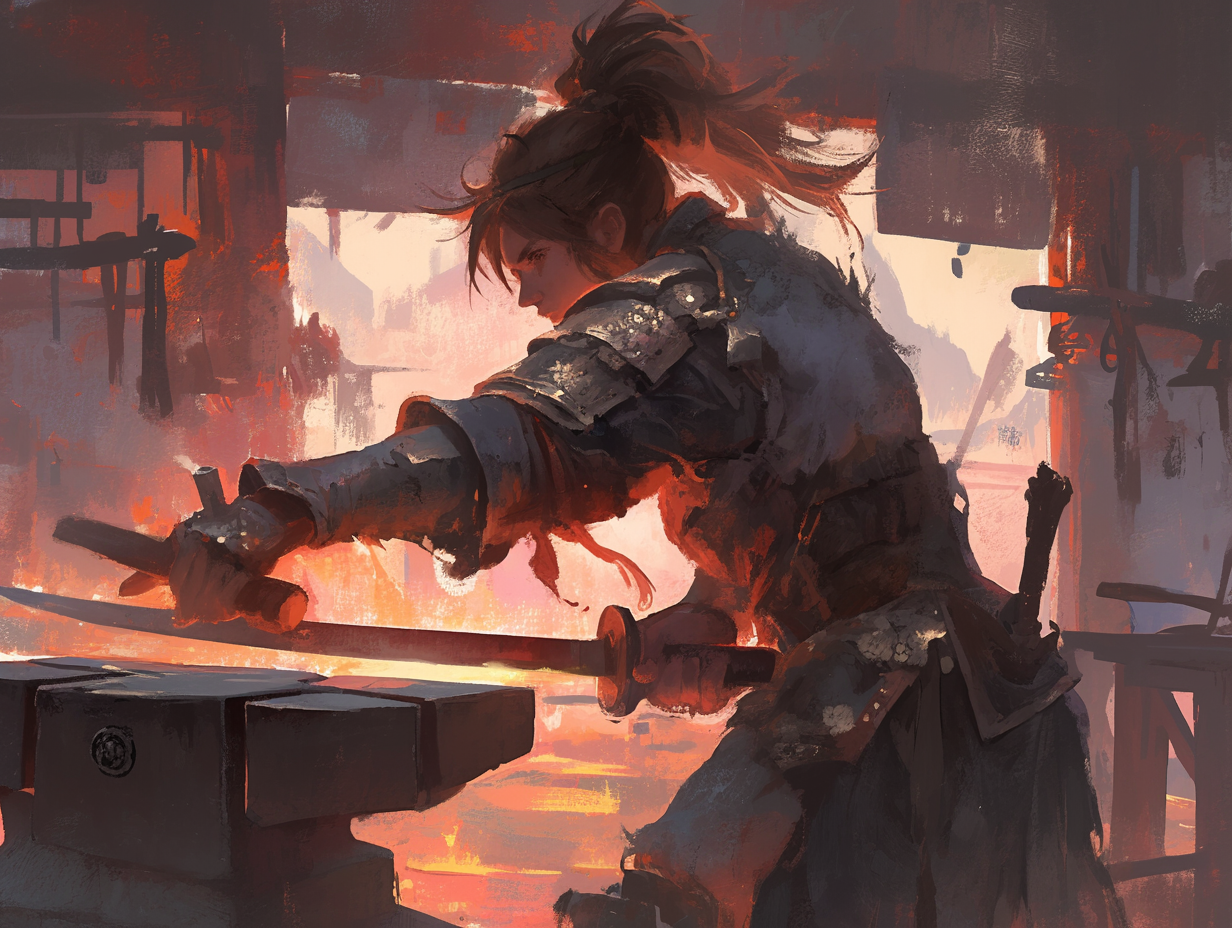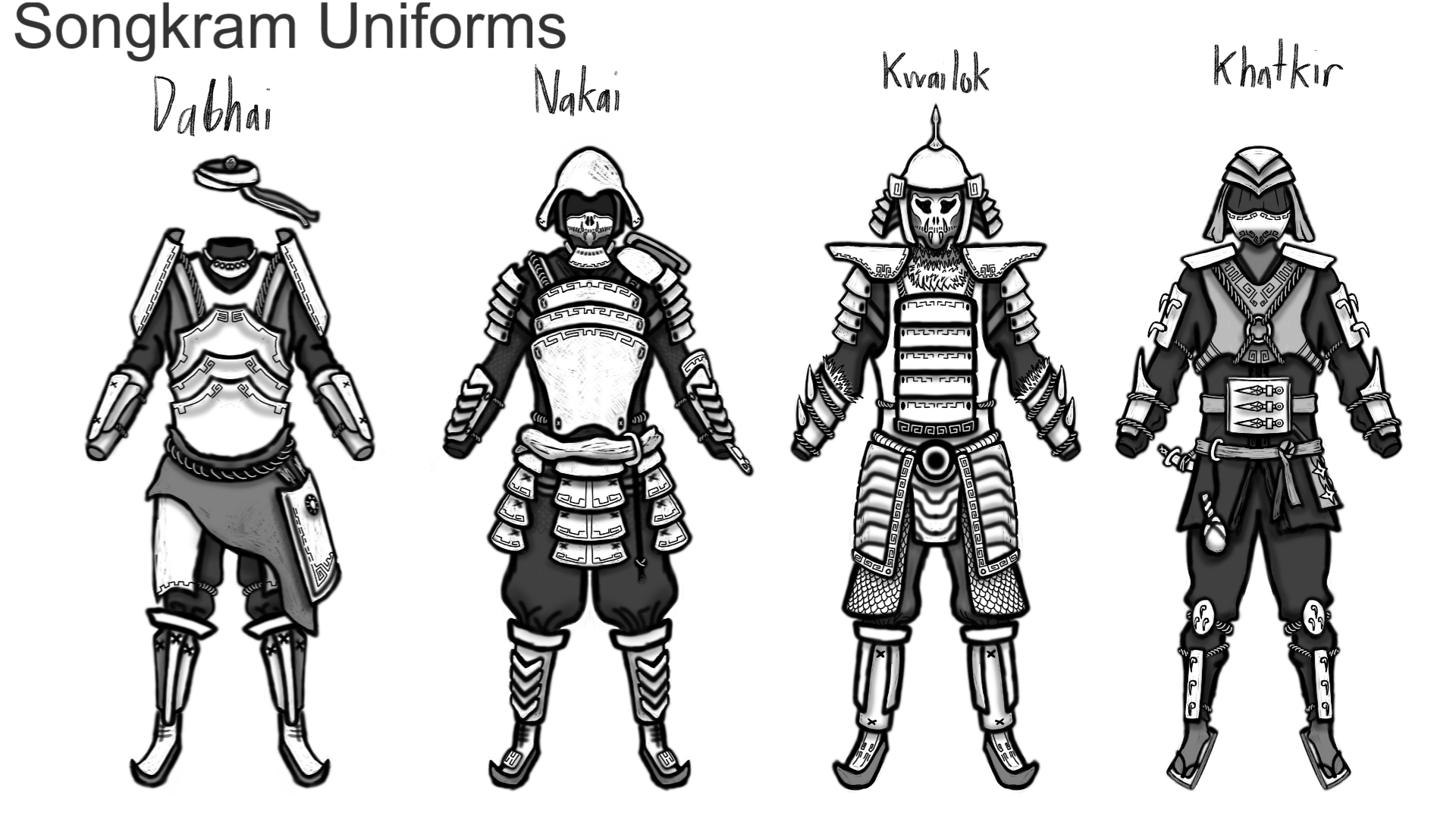Dabhai
Dabhai had been used in Isutan warfare for years to provide armor repair and new weapons in the midst of combat. They were specialized metalworkers trained to be accustomed to the stresses of working in the hostile environment that was the battlefield. They could create swords, armor, and other implements of war with great speed and precision while defending themselves.

Dabhai were also taught the arcane arts to add a new level of adaptability to Isutan forces. Djinnblades were magical weapons with certain properties that might prove useful in taking on certain obstacles facing the army. The employment of magic by the Songkram's forces was greatly expedited during the war with the Kingdom of Phovezila in 314 DHT.
Manpower & Structure #
There was usually 3 dabhai per haka of Nakai. Naturally, that dabhai followed orders from the haka's master. Under certain circumstances, up to 6 dabhai could be recruited to a single haka (for example, if the nakai were fighting in an especially hostile environment that could potentially see the fatality of a dabhai early on).
The group of dabhai worked together to carry their equipment and ensure their products were ready for use as soon as possible.
The dabhai assigned to a haka of nakai followed the orders of the nakai master in charge. Simply put, dabhai were allowed to do whatever they wanted unless a direct order was received from the master. More seasoned dabhai had been known to be so intuitive that they could predict the orders of the master before they reached their ear, and therefore the need to communicate with dabhai was dissolved for the most part.
Training #
Dabhai trainees had to undergo 15 years of training before becoming fully fledged. This is on top of the 20 years of nakai training. The primary discipline taught was metal working: each dabhai would be taught entry level armoursmithing and weaponsmithing, but had to make a choice to focus on one or the other.
- Weaponsmithing-focused dabhai were taught how to make djinnblades in their training as well.
- Armoursmithing-focused dabhai were not required to learn djinnblade forging, but would often pursue knowledge of the skill just for the prestige of knowing how.
Dabhai would also undergo intense physical training in order to allow them to pound out metal with the power, speed and precision of a machine.
Logistics #
Support & Supply Lines #
For dabhai deeply entrenched in combat zones, caravans of Starsteel, wood, Djinnstones, and other materials needed by dabhai may need to venture across the battlefield to meet them in their workshops. Other things like food, water, and feed for the dabhai wagon's horses would also need to be transported. The high value of such materials in a deadly warzone often require an armed escort. In particularly crucial battles, a grandmaster's silyuan or even some Kwailok may accompany such caravans.
Upkeep #
The warrior-blacksmiths need a constant resupply of materials when entering battle. As such, the smelting of Starsteel and mining of associated magical crystals from Fuga is greatly accelerated during and on the eve of war.
Recruitment #
Dabhai are selected from the body of graduated nakai due to their physical strength or interest in the craft of a dabhai. There are no entrance exams required to be completed, unlike Khatkir training. Instead, the grueling work involved with dabhai training automatically sifts out those who aren't suited for the job. For most sapients, typically only males end up completing dabhai training due to their natural strength when compared to females, but it is not unheard of to have female dabhai--however, the latter was far more uncommon.
Equipment #

Tools & Supplies #
Dabhai had a lot of equipment to take with them due to the nature of their work. Below is a list of gear commonly found in a dabhai's kit:
- bellows
- small portable stone forge
- coal
- octagonal Starsteel ingots
- various magical crystals
- various smithing tools including hammers, chisels, fullers, swages, sets, tongs, punches, etc.
- barrels of oil and water
- shovels
- other scrap metal
- wood
Armour #
In terms of armor, dabhai wore starsteel plate but with significantly fewer layers underneath than what might be found on Nakai. This was to prevent them from overheating in their hot work environments. A lot of armor worn by dabhai was detachable, hooking onto the dabhai's "basement level" armor- this allowed dabhai to quickly add or take off extra protection in response to hostile forces or the lack thereof. Helmets were also usually not worn by dabhai, but they could easily hammer one out for protection should the need arise.
Weaponry #
Dabhai, like Khatkir, were derived from Nakai and therefore were familiar with their weapons. However, the raw strength of a dabhai cultivated from repetitious weaponsmithing led to the use of weapons that complimented their physique.
War Cleaver - Pantakan #
A simple weapon that could be created by the dabhai with excess starsteel. Pantakan were of varying width, weight, length, and overall shape. In fact, pantakan was more of an umbrella term for hastily crafted Isutan swords. On average, pantakan blades were just under 2 meters long. They were much heavier than other swords like the kizaraka[^1] and significantly larger. Starsteel was a very light material, and dabhai had to use a lot of material to create a weapon heavy enough that only they could use effectively.
Pantakan blades were still far more clumsy than the smaller alternatives but were capable of busting through armor and sending opponents reeling when utilized properly. Incredible training was required for dabhai to use inertia to keep the pantakan's blade moving.
Improvised Weapons #
Naturally, the tools wielded by blacksmiths could also be quickly turned into a weapon if needed. For example, a metal mallet could just as easily dent an opponent's skull as an actual anti-armor weapon.
Heavy Longbow - Ju Fang #
Ju fang were massive longbows with significantly heavier poundage than their diminuitive ju pe counterparts. Dabhai's strength allowed them to pull these much heavier bows back and fire arrows with enough power to, on occasion, punch through even fire iron.
Vehicles #
Dabhai would usually have a wagon drawn by horses to aid in the transport of their extensive list of tools and equipment. In the distant past, dabhai would operate out of their wagons for increased mobility (without having to unload), but it would often lead to the wagon catching fire due to the extremely high-heat forge needed to melt starsteel into a malleable form. During the rule of the Ganpoumi Fi and the early days of the Songkram Empire, dabhai would instead unload their equipment to avoid this, although recently the Songkram had reintroduced the increased mobility of dabhai by creating specialized metal wagons that were more resistant to high temperatures.
Tactics #
Adaptive Forging #
Dabhai were equipped to forge weapons and armor for Nakai who had their armor damaged or destroyed. Additionally, they could create other types of weapons needed to deal with opponents. For example, when facing opponents with tough armor, dabhai may have quickly created batches of raujang[^2] and somaza.[^3] This equipment versatility allowed Isutan armies with dabhai to be extremely difficult to outmaneuver.
A more dramatic form of adaptation came in the form of Djinnblades. Djinnblades were magical weapons, created by dabhai who infused magical crystals into starsteel weapons. There were 5 types of djinnblades (plus a secret, obscure sixth type) developed by dabhai that were stable enough to be used on the battlefield.
The Muza
There were rumors that the Muza, an uneonaka[^4] wielded by the Songkram's warlord, was a djinnblade unlike any other. ^4b9208
Dabhai Workshop #
Dabhai usually set up shop on the battlefield about a half to one kilometer back from the front lines in order to avoid being disturbed. Unfortunately the dabhai's place wass never guaranteed to lack action- enemy troops pushing past the lines, calvary charges, and hails of stray arrows are all things that could befall a dabhai. Dabhai set up shop by erecting a simple lean-to with spare pieces of wood and sheets of hastily-hammered metal. They would often dig a small trench with the help of other nakai to help nestle the forge in the ground. Typically nakai armed with ju pe were stationed nearby the dabhai's workshop, lying vigilant behind mantlets near the area.
Elemental Detonation #
Because of the nature of a dabhai's job, a plethora of resources were always found at the site of work. To avoid these precious resources from falling into enemy hands, dabhai could enact a simple spell to destroy the supplies should the workshop be compromised without a chance to get away. The dabhai would throw all of the djinnstones together into a crucible and cast a self-destruct spell. This caused a violent chain reaction, unleashing the magical energy within the material all at once, instantly vaporizing, freezing, and slagging (all at the same time) all of the things in the workshop and the surrounding area. This usually resulted in the death of at least one of the dabhai working in the forge. It was considered a great honor by the dabhai to give one's life to prevent the enemy from prospering.
[^1]: The kizaraka was the standard weapon within the The Eastern Provinces, being a single-edge, curved sword with a small, round handguard. [^2]: A spear with a traditional spearhead on one side and a heavy metal block on the other end. The raujang was used to counter opponents with heavy armour, employing the weighted side of the spear like a club to crush the enemy's armour. [^3]: Somaza were infamous for mashing their targets into paste. The somaza was a club weapon with metal rivets designed to overcome heavy armour. The need to swing the weapon in wide arcs made it less ideal for urban combat environments or other confined spaces. [^4]: A sword-polearm hybrid with long reach.